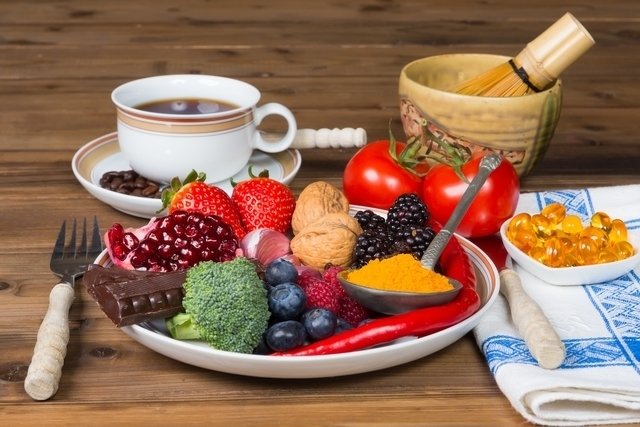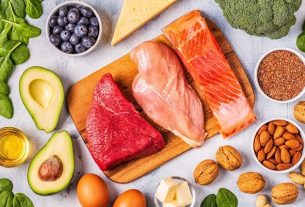Polyphenols are organic compounds found mainly in plants and fruits, which have the function of protecting them against insects, ultraviolet radiation and microbial infections. These substances can be ingested by humans through food, and can be found in foods such as red wine, green tea, chocolate or saffron, for example.
Due to their properties, mainly antioxidants and anti-inflammatory, polyphenols bring several health benefits, from regulating metabolism and helping with weight control, to preventing chronic diseases and preventing the emergence of cancer.
There are more than 8 thousand types of polyphenols identified, the best known and studied of which are catechins, resveratrol, curcumin, anthocyanins and flavonoids.

Main benefits
Polyphenols have been extensively studied due to their potential health benefits and, although most studies have been carried out on animals or in laboratories, their consumption has been associated with the following benefits:
1. Prevention of neurodegenerative diseases
Some polyphenols such as curcumin, resveratrol and catechins appear to be able to protect against neurodegenerative diseases such as Alzheimer’s, Parkinson’s, Huntington’s disease and dementia. This is due to its antioxidant, immunomodulatory and purifying properties that protect brain cells and inhibit the accumulation of a protein that causes toxic effects on neurons, called beta-amyloid, and which is directly related to Alzheimer’s disease.
Likewise, it is believed that the compounds found in cocoa, grape juice and ginkgo biloba, for example, can also promote memory and concentration, as they improve the flow of blood circulation in the brain.
2. Improved cardiovascular health
Polyphenols, in general, help to improve the functioning of the heart, as they have anti-inflammatory and antioxidant properties that reduce platelet activity, thus improving blood circulation and helping to control blood pressure.
Likewise, flavonoids and resveratrol help reduce LDL cholesterol, known as “bad”, which reduces the risk of cardiovascular diseases, such as atherosclerosis, for example. Check out the properties of resveratrol and how it should be consumed.
3. Cancer prevention
Flavonoids, flavones, catechins, anthocyanins and isoflavones are polyphenols that, due to their powerful antioxidant action, are capable of neutralizing free radicals, preventing the growth of tumor cells and thus reducing the risk of suffering from some types of cancer such as colon, prostate, breast or endometrial.
4. Fight obesity
Some polyphenols such as catechins, resveratrol and curcumin appear to have anti-obesity effects, as they promote weight loss or help maintain it. This is because these substances can prevent the accumulation of body fat, reduce inflammation, increase energy expenditure and promote fat oxidation.
See how to use turmeric, rich in curcumin, to obtain its benefits, in this video:
5. Prevention and improvement of diabetes
Some polyphenols, mainly anthocyanins, have been associated with both the prevention and control of type 2 diabetes, as they exert anti-inflammatory and antioxidant effects that help protect the cells in the pancreas responsible for producing insulin, the hormone that regulates amount of sugar in the blood.
In addition, polyphenols have also been associated with decreasing carbohydrate digestion at the intestinal level and regulating and altering glucose transport, which helps control blood sugar.
6. Regulation of intestinal flora
Polyphenols may have a high potential to interact with the intestinal microbiota and bring health benefits, acting as a type of probiotic that helps improve digestion and the functioning of the gastrointestinal tract. It is believed that this may occur because the metabolites produced by polyphenols appear to inhibit the growth of invasive species of gut bacteria.
Some evidence suggests that green tea extract may regulate the growth of bacteria such as Clostridium difficile, Escherichia coli e Salmonella typhimurium; or that blueberry juice extract promotes the presence of beneficial bacteria, such as bifidobacteria, for example. However, more studies are needed.
See more about the benefits of probiotics.
7. Reduction of menopause and PMS symptoms
Some polyphenols, such as isoflavones, flavones, resveratrol and lignins, help alleviate the symptoms of menopause and premenstrual syndrome (PMS), by regulating and balancing estrogen levels in the body.
Main foods with polyphenols
This table includes the most common types of polyphenols and what foods they are present in:
It is important to include these foods in a varied and balanced diet to obtain all their benefits.
There are also supplements that can be purchased in pharmacies or health food stores that provide these compounds, but they must be used with care and always under the guidance of a nutritionist or other health professional.

Sign up for our newsletter and stay up to date with exclusive news
that can transform your routine!
Warning: Undefined array key "title" in /home/storelat/public_html/wp-content/plugins/link-whisper-premium/templates/frontend/related-posts.php on line 12
Warning: Undefined array key "title_tag" in /home/storelat/public_html/wp-content/plugins/link-whisper-premium/templates/frontend/related-posts.php on line 13



